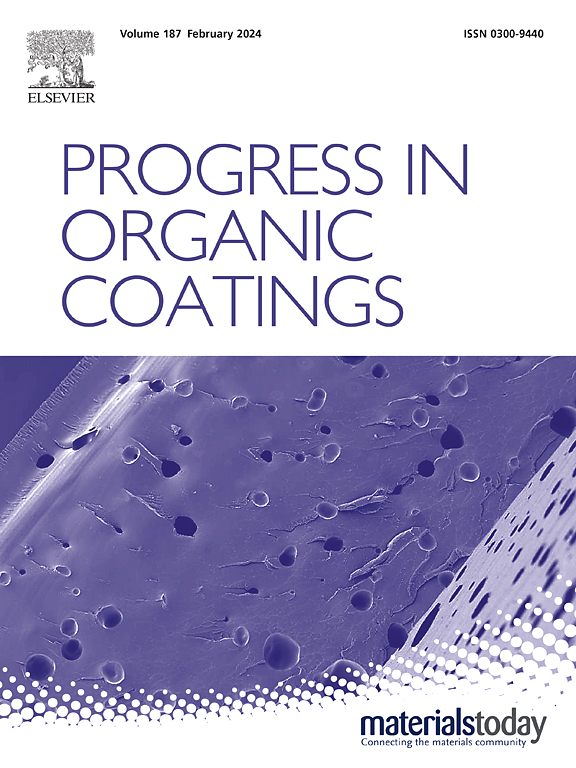bta掺杂ZIF-8修饰的夹层结构MXene/LDH纳米复合材料用于环氧涂料的主动/被动协同防腐
IF 6.5
2区 材料科学
Q1 CHEMISTRY, APPLIED
引用次数: 0
摘要
二维mxeni纳米填料在增强涂层的被动腐蚀防护方面显示出巨大的潜力;然而,在持续的腐蚀过程中,它们缺乏有效的保护。为了解决这一问题,我们开发了一种新型的三明治结构复合纳米容器(BZ@MXene/LDH),将MXene的被动阻挡作用与层状双氢氧化物和苯并三唑的主动保护功能结合起来。在该体系中,通过共沉淀法在Ti3C2Tx MXene上原位合成Zn−Al层状双氢氧化物(LDH)作为Cl−的捕获位点,同时集成负载1h -苯并三唑的沸石咪唑骨架(BZ)用于酸响应缓蚀剂的释放。在pH = 3.0条件下,BZ@MXene/LDH纳米复合材料在30 min内快速释放约74%的BTA,同时在NaCl溶液中也表现出有效的Cl -吸附。EIS分析证实了BZ@MXene/LDH在涂料中的长期防腐效果,纳米容器掺杂的水性环氧涂料在盐溶液中浸泡42 d后,|Z|0.01Hz值为6.91 × 109,比纯环氧树脂提高了3个数量级。电位极化测量结果表明,浸泡36 h后,涂层的缓蚀率为90.5%,而EIS分析表明,BZ@MXene/LDH与涂层一起有效抑制了界面腐蚀。力学测试表明,纳米容器掺入后,附着力和摩擦阻力得到改善。该复合结构将MXene的被动屏障效应与BZ和LDH的主动保护相结合,其中MXene形成物理屏障,BZ促进按需释放BTA, LDH吸附Cl -,从而赋予涂层对金属基底的更持久的保护。这项工作提出了一种开发自修复防腐涂层的新方法,该涂层结合了主动和被动保护机制。本文章由计算机程序翻译,如有差异,请以英文原文为准。
A sandwich-structured MXene/LDH nanocomposite decorated with BTA-doped ZIF-8 for active/passive synergistic corrosion protection of epoxy coatings
Two-dimensional MXene-based nanofillers have demonstrated significant potential in enhancing the passive corrosion protection of coatings; however, they lack active protection during ongoing corrosion processes. To address this limitation, a novel sandwich-structured composite nanocontainer (BZ@MXene/LDH) was developed, integrating the passive barrier effect of MXene with the active protective functions of layered double hydroxide and benzotriazole. In this system, Zn−Al layered double hydroxide (LDH) was synthesized in situ on Ti3C2Tx MXene via co-precipitation to act a trapping site for Cl−, while 1H-benzotriazole-loaded zeolitic imidazolate framework (BZ) was integrated for the acid-responsive corrosion inhibitor release. The BZ@MXene/LDH nanocomposite demonstrated a rapid release of approximately 74 % of BTA within 30 min at pH = 3.0, while also exhibiting effective Cl− adsorption in NaCl solution. The long-term corrosion protection efficacy of BZ@MXene/LDH in coatings was confirmed by EIS analysis, which showed a |Z|0.01Hz value of 6.91 × 109 for the nanocontainer-doped waterborne epoxy coating after 42 d of immersion in salty solution, representing a three-order-of-magnitude improvement over pure epoxy. Potentiodynamic polarization measurements revealed a corrosion inhibition of 90.5 % after 36 h of immersion, while EIS analysis of defective coatings demonstrated that BZ@MXene/LDH with the coatings effectively suppressed interfacial corrosion. Mechanical testing showed improved adhesion and friction resistance upon nanocontainer incorporation. The composite structure combines the passive barrier effect of MXene with the active protection of BZ and LDH, where MXene forms a physical barrier, BZ facilitates on-demand BTA release, and LDH adsorbs Cl−, thereby endowing the coating with a longer-lasting protection against metal substrates. This work presents a novel approach for developing self-healing anticorrosion coatings that integrate both active and passive protection mechanisms.
求助全文
通过发布文献求助,成功后即可免费获取论文全文。
去求助
来源期刊

Progress in Organic Coatings
工程技术-材料科学:膜
CiteScore
11.40
自引率
15.20%
发文量
577
审稿时长
48 days
期刊介绍:
The aim of this international journal is to analyse and publicise the progress and current state of knowledge in the field of organic coatings and related materials. The Editors and the Editorial Board members will solicit both review and research papers from academic and industrial scientists who are actively engaged in research and development or, in the case of review papers, have extensive experience in the subject to be reviewed. Unsolicited manuscripts will be accepted if they meet the journal''s requirements. The journal publishes papers dealing with such subjects as:
• Chemical, physical and technological properties of organic coatings and related materials
• Problems and methods of preparation, manufacture and application of these materials
• Performance, testing and analysis.
 求助内容:
求助内容: 应助结果提醒方式:
应助结果提醒方式:


